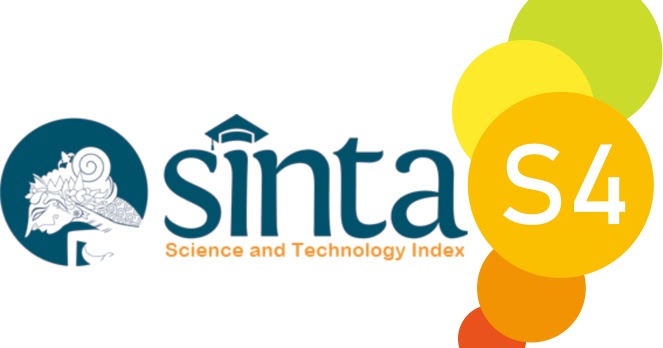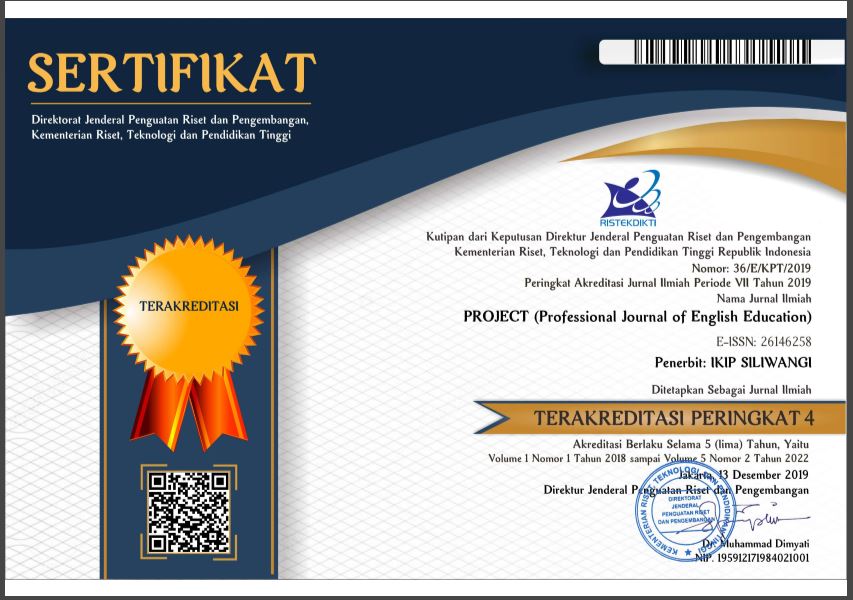AN ANALYSIS OF CLASSROOM INTERACTION PATTERNS APPLIED BY A THAI ENGLISH TEACHER IN AN ENGLISH FOR YOUNG LEARNER CLASSROOM AT SUANSANTI SCHOOL IN BANGKOK
Abstract
Classroom interactions are believed to play important role in determining the success of teaching and learning process. This study aims to find the types of classroom interaction pattern applied by a Thai English teacher in an EYL classroom, show the dominant pattern applied, and reveal the impacts of applying the classroom interaction patterns applied to the EYL teaching and learning. The descriptive qualitative method was used in this study. The data were gained through classroom observation and semi-structured interview involving a Thai English teacher and 42 students in class 5/2 elementary school at Suansanti school, Bangkok. This study used video recording, as the data collecting technique and analyzed by adapted Miles’ et al. (2014) procedures. The results indicate that there were five classroom interaction patterns applied by the Thai English teacher. Three dominant patterns applied were choral responses (36.52%), teacher talk (27.54%), and close-ended teacher questioning (26.96%). The patterns applied lead to the positive impacts including build a sense of comfort and belonging, promote students’ motivation, and enhance social development. However, the overuse of the pattern limits students’ individual expression and peer-to-peer interaction, leading to negative impact such as passive participation.
References
Afriyanto, H., Harahap, A., & Azwandi. (2018). An analysis of interactional pattern between teacher and student in SMAN 1 Curup Kota. JOALL (Journal of Applied Linguistics and Literature), 3(1), 116–128.
Bolton, K. (2008). English in Asia, Asian Englishes, and the issue of proficiency. English Today, 24(2), 3–12. https://doi.org/10.1017/S026607840800014X
Brock-Utne, B. (2007). Learning Through a Familiar Language Versus Learning Through a Foreign Language - A Look into Some Secondary School Classrooms in Tanzania. International Journal of Educational Development, 27(5), 487–498. https://doi.org/10.1016/j.ijedudev.2006.10.004
Bruner, D. A., Sinwongsuwat, K., & Radić-Bojanić, B. (2015). EFL oral communication teaching practices: A close look at university teachers and A2 students’ perspectives in Thailand and a critical eye from Serbia. English Language Teaching, 8(1), 11–20. https://doi.org/10.5539/elt.v8n1p11
Chanaroke, U., & Niempraan, L. (2020). The Current Issue of Teaching English in Thai Context. EAU Heritage Journal Social Science and Humanity, 10(2), 34–45.
Charoensap, C. (2017). Moderate Class, More Knowledge. Vocational Subjects in Primary School Curriculum in Thailand. Journal of Education, Mahasarakham University, 11(4).
Copland, F., Garton, S., & Burns, A. (2014). Challenges in Teaching English to Young Learners: Global Perspectives and Local Realities. TESOL Quarterly, 48(4), 738–762. https://doi.org/10.1002/tesq.148
Cuesta, J., & Madrigal, L. (2014). Equity in Education Expenditure in Thailand. Development Policy Review, 32(2), 239–258. https://doi.org/10.1111/dpr.12053
Dornyei, Z. (2007). Research methods in applied linguistics. Oxford university press.
Englehart, J. M. (2009). Teacher–student interaction. In International handbook of research on teachers and teaching (pp. 711-722). Boston, MA: Springer US.
Farrelly, M. J., & Sinwongsuwat, K. (2021). Strategies Used and Challenges Faced by Thai EFL Teachers When Eliciting Talk During Classroom Interactions in High School Contexts. SAGE Open, 11(4). https://doi.org/10.1177/21582440211050385
Hayes, D. (2008). Becoming a teacher of English in Thailand. Language Teaching Research, 12(4), 471–494. https://doi.org/10.1177/1362168808097160
Hikmah, N., Zurnelli, N., & Andriyani, R. (2019). The Classroom Interaction in The English Teaching Learning Process of The Eight Graders at MTS Negeri 8 Muaro Jambi (Doctoral dissertation, UIN Sulthan Thaha Saifuddin Jambi).
Khamkhien, A. (2010). Teaching English Speaking and English Speaking Tests in the Thai Context: A Reflection from Thai Perspective. English language teaching, 3(1), 184-190.
Mardiyana, F., Zainuddin, & Jefria Gultom, J. (2018). Verbal Interaction in English Classroom Using Flanders Interaction Analysis Categories System (FIACS). Journal of Applied Linguistics of FBS Unimed, 7(3). https://doi.org/10.24114/genre.v7i3.12443
Martina, F., Utari, I. R., & Riza, S. (2021). An analysis on teacher talk using Flanders interaction analysis categories (FIAC). International Journal of Innovation and Education Research, 1(1), 31-52.
Miles, M. B., Huberman, A. M., & Saldaña, J. (2014). Qualitative Data Analysis: A Methods Sourcebook Edition (Third Edition). SAGE Publications.
Minalla, A. A. (2022). From EFL Teachers’ Perspective: Impact of EFL Learners’ Demotivation on Interactive Learning Situations at EFL Classroom Contexts. English Language Teaching, 15(3), 1–8. https://doi.org/10.5539/elt.v15n3p1
Office of the Basic Education Commission. (2008). Basic education core curriculum. Bangkok: Bureau of Academic Affairs and Educational Standards.
Noom-Ura, S. (2013). English-teaching problems in Thailand and Thai teachers’ professional development needs. English Language Teaching, 6(11), 139–147. https://doi.org/10.5539/elt.v6n11p139
Orosz, A. (2007). Teaching Young Language Learners. Oxford University Press, 35(3), 401–403. https://doi.org/10.1016/j.system.2007.06.001
Phothongsunan, S. (2019). Revisiting English learning in Thai schools: why learners matter. NIDA Journal of Language and Communication, 24(35), 97-104.
Prihatin, Y., Ekawati, Y. N., Rosdiana, I., & Sakinatulhaq, A. (2021). Challenges in teaching English to young learners in southern Thailand (A case study of Indonesian pre-service teachers’ perspectives). Psychology and Education Journal, 58(2), 6098-6107. https://doi.org/10.17762/pae.v58i2.3087.
Prihatin, Y., Sumartono, I. R., & Prawitasari, R. (2021, January). Students’ Perception of English Teacher and Apprentice Teacher on Learning English (A Case Study of Elementary School in Southern Thailand). In ICONS 2020: Proceedings of the 1st International Conference on Social Science, Humanities, Education and Society Development, ICONS 2020, 30 November, Tegal, Indonesia (p. 365). European Alliance for Innovation.
Ramadhani, P., & Hikmat, M. H. (2018). Classroom Interaction In A Speaking Class At The Eighth Grade Of Junior High School 2 Colomadu Karanganyar (Doctoral dissertation, Universitas Muhammadiyah Surakarta).
Sari, F. M. (2019). Patterns of teaching-learning interaction in the EFL classroom. Teknosastik, 16(2), 41-48.
Selamat, E. H., & Melji, S. M. (2022). Investigating the Interactions between Teacher and Students in an EFL Classroom. English Language Education Journal (ELEJ), 1(1), 23-42.
Sihem, B. (2020). The Impact of Classroom Interaction Patterns on Enhancing Learning in EFL classes: Case of Second Tear Secondary School of Mohamed ben Ahmed Abd Alleghany Mostaganem English Studies.
Storch, N. (2005). Collaborative writing: Product, process, and students’ reflections. Journal of Second Language Writing, 14(3), 153–173. https://doi.org/10.1016/j.jslw.2005.05.002
Sundari, H. (2017). Classroom interaction in teaching English as foreign language at lower secondary schools in Indonesia. Advances in Language and Literary Studies, 8(6), 147. https://doi.org/10.7575/aiac.alls.v.8n.6p.147
Teng, B., & Sinwongsuwat, K. (2015). Teaching and learning English in Thailand and the integration of conversation analysis (CA) into the classroom. English Language Teaching, 8(3), 13–23. https://doi.org/10.5539/elt.v8n3p13
Trakulkasemsuk, W. (2018). English in Thailand: looking back to the past, at the present and towards the future. Asian Englishes, 20(2), 96–105. https://doi.org/10.1080/13488678.2017.1421602
Ulla, M. B. (2018). English language teaching in Thailand: Filipino teachers' experiences and perspectives. Issues in Educational Research, 28(4), 1080-1094.
Ur, P. (1999). A course in language teaching: Practice and theory. Cambridge Cambridge University Press.
Vibulphol, J., Prabjandee, D., Chantharattana, M., & Bupphachuen, P. (2021). English Teachers’ Understanding of Thailand Basic Education Core Curriculum. English Language Teaching, 14(11), 128. https://doi.org/10.5539/elt.v14n11p128
Vygotsky, L. S., & Cole, M. (1978). Mind in society: Development of higher psychological processes. Harvard university press.
Weizheng, Z. (2019). Teacher-Student Interaction in EFL Classroom in China: Communication Accommodation Theory Perspective. English Language Teaching, 12(12), 99. https://doi.org/10.5539/elt.v12n12p99
Wibowo, L. (2017). Classroom interaction in an EYL classroom. Magister Scientiae, (41), 31-40.
Wigglesworth, G., & Storch, N. (2009). Pair versus individual writing: Effects on fluency, complexity and accuracy. Language Testing, 26(3), 445–466. https://doi.org/10.1177/0265532209104670
Wiriyachitra, A. (2002). English language teaching and learning in Thailand in this decade. Thai TESOL focus, 15(1), 4-9.
Zhan, Z., Wu, Q., Lin, Z., & Cai, J. (2021). Smart classroom environments affect teacher-student interaction: Evidence from a behavioural sequence analysis. Australasian Journal of Educational Technology, 37(2), 123–136. https://doi.org/10.14742/AJET.6523
Downloads
Published
Issue
Section
License

This work is licensed under a Creative Commons Attribution-ShareAlike 4.0 International License.




